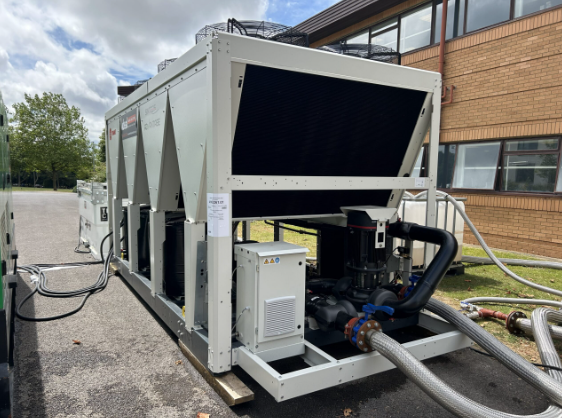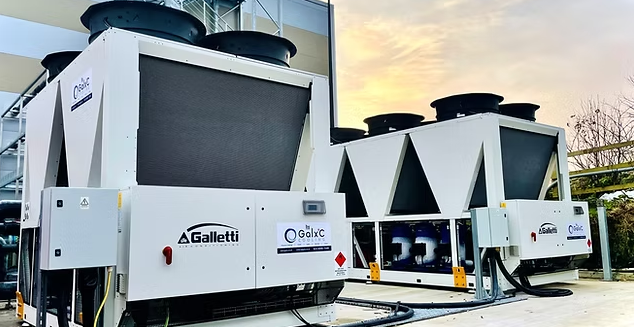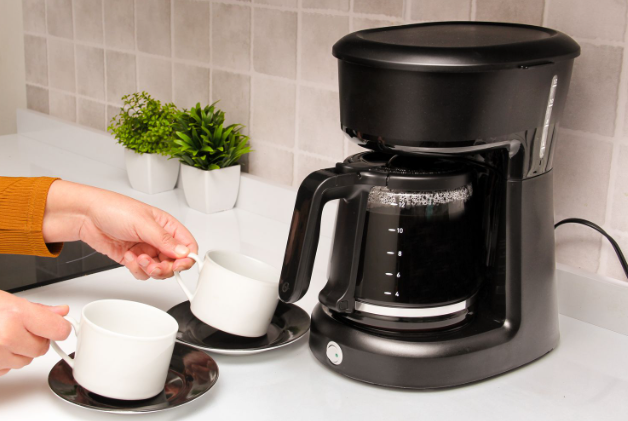Air conditioning systems are crucial in hotter and humid regions. Amongst different types of systems like split systems and central systems, chiller AC stands out as the most powerful one. It is primarily used in large commercial buildings, industrial plants, and even hospitals that need continuous and reliable cooling. In this review, my emphasis is on chiller AC systems, their functions, types, and their advantages in comparison to more traditional systems.
What is a chiller AC?
Chiller AC is a specific cooling system with two main types: vapor-compression and absorption. Unlike most air conditioning systems, chiller AC does not refrigerate the air; rather, it thermally reduces the temperature of water or other liquids, which is used to cool air in the air washing systems and in the fan coil units.
Chiller AC systems are well-suited for large-scale cooling tasks like temperature control for a number of rooms, multiple floors, or even entire buildings.
What are the Steps in Working for Chiller ACs?
Like many other innovations in the technical world, Chiller ACs have been developed for complex, yet seamless, functioning. Below are the steps:
Heat Absorption: The flow loops for the warm water within the building circulate to the evaporator section of the chiller. Within the chamber of the evaporator, the refrigerant will thermally kill water and absorb the water’s heat.
Compression: For Chiller ACs, the now overheated refrigerant vapor will be transported to a compressor, where the vapor’s temperature and pressure will be further elevated.
Heat Rejection: From the evaporator, the refrigerant goes to the condenser. The refrigerant is in a hot, high-pressure state, and the heat absorbed is released. The heat is either expelled by water-cooled or air-cooled chillers.
Expansion: The refrigerant has a temperature and pressure reduction, and the temperature is lowered. The process completes as the refrigerant is returned to the evaporator after the expansion valve is passed and pressure, as well as temperature, is lowered.
The water is then used to chill and is applied for air conditioning and for process cooling in industries, as well as for medical applications.
Chiller AC Systems and Their Different Types
Different arrangements of Chiller ACs are constructed to satisfy specific cooling needs.
Chillers can be divided into two categories: air-cooled and water-cooled chillers.
1. Air Cooled Chiller AC
The refrigerant gas in these air conditioners is in gaseous form and is cooled by fans.
Air coolers have a low initial and operational cost.
This AC is ideal considering the user’s purpose and requirement.
Air-cooled chillers are noisier and less energy-efficient as compared to water-cooled systems.
2. Water Cooled Chiller AC
These chillers use water from a cooling tower to refrigerate and cool the refrigerant.
Water coolers and chillers have a low and partial cooling load efficiency, are noisier, and have limited cooling capacity.
These freshwater systems are used in commercial buildings, malls, universities, and clinics.
These chillers are less cost-efficient compared to air coolers due to the added expenses for water treatment systems, cooling systems, and water treatment costs.
3. Absorption Chillers
These chillers can be powered by waste heat and do not have a mechanical compressor. Instead, they can be powered by heat from natural gas, steam, or solar energy.
Businesses looking to be environmentally friendly and utilize waste heat would benefit from these chillers.
Compared to mechanical systems, these systems have lower efficiency.
Benefits of Chiller AC Systems
Chiller ACs are becoming increasingly popular as they offer several advantages over traditional air conditioning systems.
1. Maximized Efficiency for Large Spaces
The need for numerous smaller units comes with hefty operational costs. In contrast, a single chiller serving an entire building drastically reduces energy costs. For large cooling requirements, Chiller ACs are much more efficient than several smaller units.
2. Increased Flexibility and Scalability
These systems are more suitable for varying temperature requirements because they operate on chilled water. This is a boon for large office complexes, hotels, and shopping malls, which have different temperature control needs at different times of the day.
3. Enhanced Durability and Increased Lifespan
These units provide a greater long-term value as they can outlast traditional AC units. This is because chillers are designed for heavy and consistent loads, thus making them a smart investment.
4. Reduced Noise Pollution
These systems are more suited for sensitive locations like hospitals and research facilities, as they operate quietly than other large HVAC systems with multiple windows or split units.
5. Reduced Noise Pollution
There is a significant reduction in noise pollution as a result of the energy-efficient features that are integrated into Chiller Systems.
This and similar units that use renewable energy systems or absorption systems represent an ecologically sustainable option for cooling.

Chiller AC Systems: Their Challenges
Like with any other system with benefits, Chiller AC systems have some limitations or challenges that need to be considered.
High Installation Cost: Some systems implement wwater-cooledchillers which have water systems that need considerable financial resources for the infrastructure.
Maintenance: These mechanical systems require periodic water treatment and other maintenance checks that need to be done on a routine basis.
Physical Space: These chillers, together with the piping networks and cooling towers, require a lot of physical space, which smaller buildings do not have.
Small Applications: These systems may be inefficient for smaller buildings compared to some more traditional systems, which would adversely impact productivity.
Applications of Chiller AC Systems
Chiller systems are particularly good for the following applications owing to their flexibility.
Commercial Buildings: Centralized chillers are used in offices, malls, and hotels.
Hospitals: These are crucial to keep steady temperatures for patients and delicate surgical instruments.
Data Centers: These are used for low-temperature control of the servers and other IT equipment.
Industrial Facilities: precise cooling is necessary in some manufacturing processes.
Educational Institutions: Their cost-effective cooling aids large schools and universities.
Table of Contents
Final Thoughts
The chiller air conditioning system is much more than a cooling system. Especially for large-scale facilities where efficiency, reliability, and scalability are important, these systems offer a backbone solution. Smaller-scale users may not find the appeal of these systems due to the high initial and maintenance costs, but the long-term savings and performance achieved more than compensate for the initial investment, especially for businesses and institutions.
If you are a business owner or a facility manager, or even someone interested in advanced cooling systems, understanding the operation, classification, and benefits of chiller AC systems helps you with the knowledge of making well-informed decisions. The advanced chiller AC systems are important and will continue to be crucial in the future for climate control, as there is a growing need for more efficient cooling solutions.



